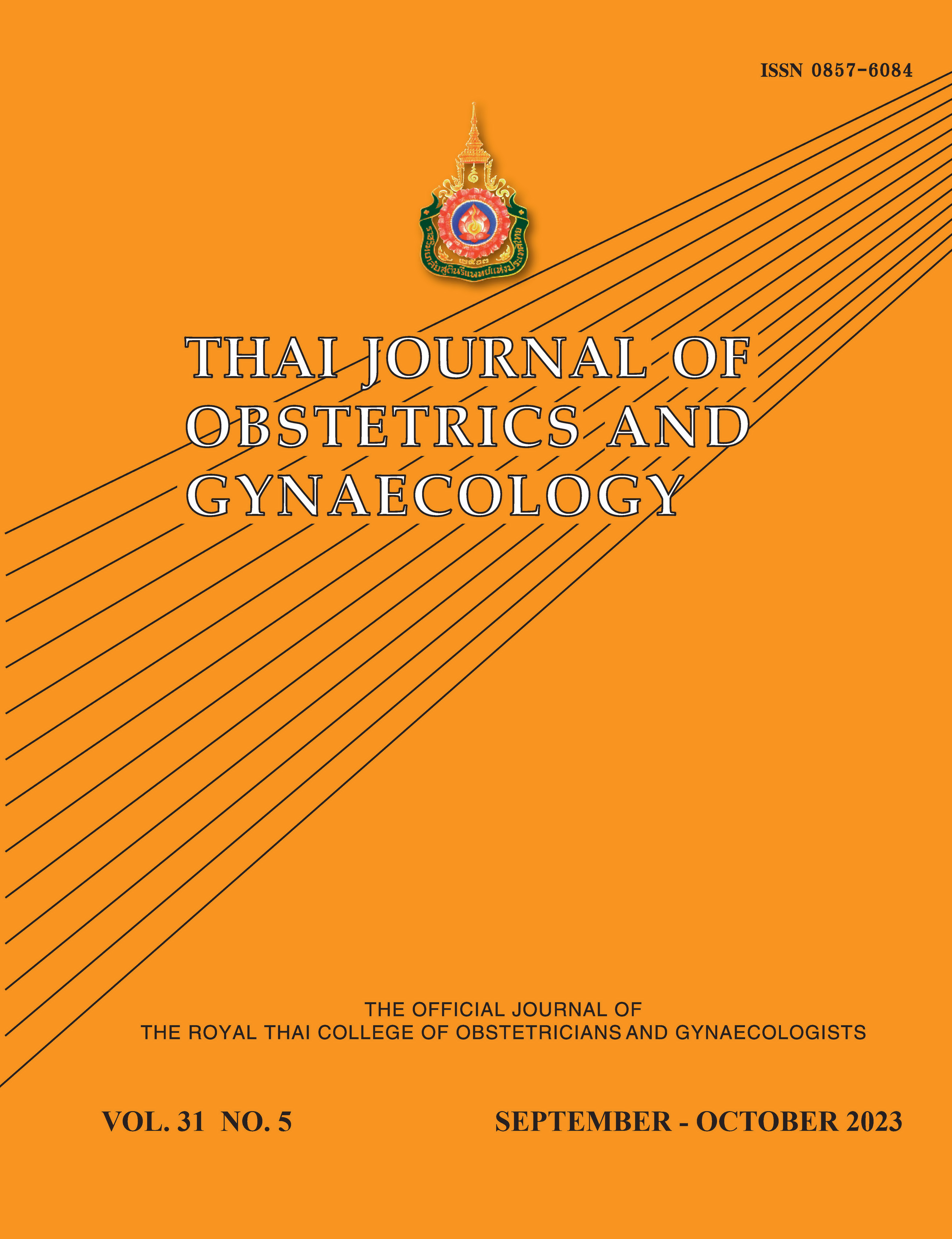Treatments and Outcomes of Epithelial Ovarian Cancers in Srinagarind Hospital
Main Article Content
Abstract
Objectives: To compare treatments of epithelial ovarian cancers (including fallopian tube cancer and primary peritoneal adenocarcinoma) with national guidelines and oncological outcomes between standard and non-standard treatment groups.
Materials and Methods: Retrospective chart reviews were performed on patients with epithelial ovarian cancers, fallopian tube cancer and primary peritoneal adenocarcinoma (n = 318) who had been registered in Department Obstetrics and Gynecology, Srinagarind Hospital, between January 1st, 2014 and December 31st, 2019. Surgical treatments and adjuvant treatments were compared with national guidelines. Oncological outcomes were compared between standard and non-standard treatment groups. Univariate and multivariate logistic regression analyses were used for factors to receive which treatment. Survival rates were analyzed by Kaplan-Meier and prognostic factors were compared among the two groups by Cox-regression for factors to receive longer overall survival.
Results: A total of 318 patients were recruited. Most patients were diagnosed with epithelial ovarian cancers (89.9%). The major pathology was high grade carcinoma (53.8%). Surgeries were done in most patients (92.1%), which were primary cytoreductive surgery (72.4%) and complete surgical staging (80.5%). Residual tumors of more than 5 mm in diameter were left in 42.3%. Standard and non-standard treatment of epithelial ovarian cancers were found in 60.4% (95% confidence interval: 54.9-65.6%) and 39.6%, respectively. Chemotherapies were given to most patients (86.8%). Five-year survival rates and recurrence free survival rates were 42.2% and 26.8%. Overall survival rate was significantly lower in the non-standard group (adjusted hazard ratio = 1.42, 95% confidence interval: 1.01-2.02, p = 0.046).
Conclusion: National guidelines on treatment of epithelial ovarian cancers should be followed, because of poorer outcomes in the non-standard groups.
Article Details

This work is licensed under a Creative Commons Attribution-NonCommercial-NoDerivatives 4.0 International License.
References
Arora T, Mullangi S, Lekkala MR. Ovarian cancer. In: StatPearls [Internet]. Treasure Island (FL): StatPearls Publishing, 2022. Available from: https://www.ncbi.nlm.nih.gov/books/NBK567760/
National Institutes of Health. Cancer Stat Facts: Ovarian cancer [Internet]. 2022. Available from: https://seer.cancer.gov/statfacts/html/ovary.html
Rojanamatin J, Ukranun W, Supaattagorn P, Chiawiriyabunya I, Wongsena M, Chaiwerawattana A, et al. Cancer in Thailand Vol X, 2016-2018. Bangkok: National Cancer Institute 2021:1-171.
American Cancer Society. About ovarian cancer [Internet]. 2022. Available from: https://www.cancer.org/cancer/ovarian-cancer/about/key-statistics.html
National Health Security Organization (NHSO). Adult cancer treatment guideline. Bangkok: Sahamit Printing and Publishing 2018:1-167.
Thai Gynecological Cancer Society (TGCS). Ovarian cancer treatment guideline. Nonthaburi: PCK Design 2019:1-114.
Panprom P, Lertkhachonsuk R. Outcome of ovarian cancer patients who underwent incomplete surgical staging. J Med Assoc Thai 2008;91:1323-30.
Bun S, Yunokawa M, Ebata T, Kato MK, Shimoi T, Kato T, et al. Feasibility of initial treatment in elderly patients with ovarian cancer in Japan: A retrospective study. Int J Clin Oncol 2019;24:1111-8.
Fourcadier E, Trétarre B, Gras-Aygon C, Ecarnot F, Daurès J, Bessaoud F. Under-treatment of elderly patients with ovarian cancer: A population based study. BMC Cancer 2015;15:937.
Yoshikawa K, Fukuda T, Uemura R, Matsubara H, Wada T, Kawanishi M, et al. Age related differences in prognosis and prognostic factors among patients with epithelial ovarian cancer. Mol Clin Oncol 2018;9:329-34.
Trillsch F, Woelber L, Eulenburg C, Braicu I, Lambrechts S, Chekerov R, et al. Treatment reality in elderly patients with advanced ovarian cancer: a prospective analysis of the OVCAD consortium. J Ovarian Res 2013;6:42.
Sabatier R, Calderon B Jr, Lambaudie E, Chereau E, Provansal M, Cappiello MA, et al. Prognostic factors for ovarian epithelial cancer in the elderly: a case-control study. Int J Gynecol Cancer 2015;25:815-22.
Rauh-Hain JA, Melamed A, Wright A, Gockley A, Clemmer JT, Schorge JO, et al. Overall survival following neoadjuvant chemotherapy vs primary cytoreductive surgery in women with epithelial ovarian cancer: analysis of the national cancer database. JAMA Oncol 2017;3:76-82.
Schuurman MS, Kruitwagen RFPM, Portielje JEA, Roes EM, Lemmens VEPP, van der Aa MA. Treatment and outcome of elderly patients with advanced stage ovarian cancer: A nationwide analysis. Gynecol Oncol 2018;149:270-4.


